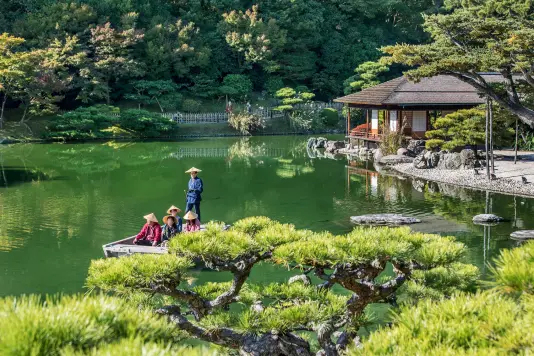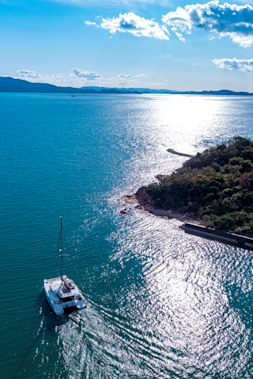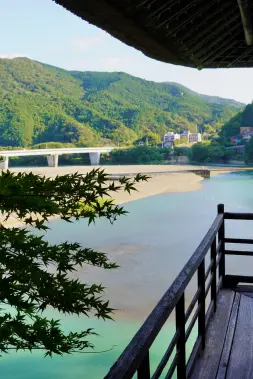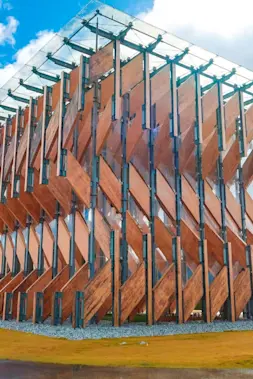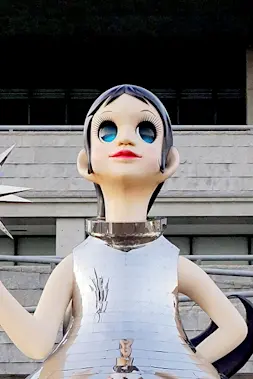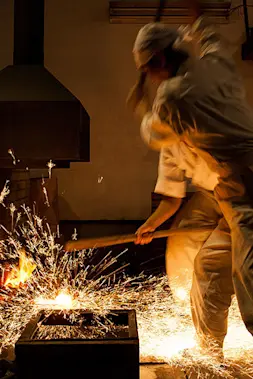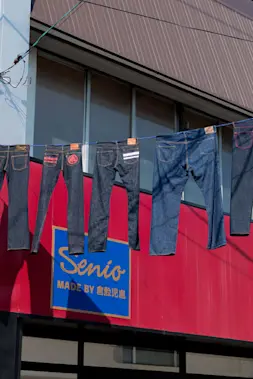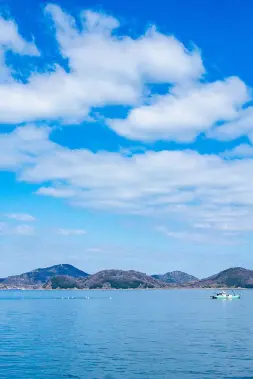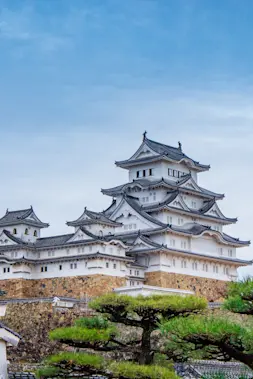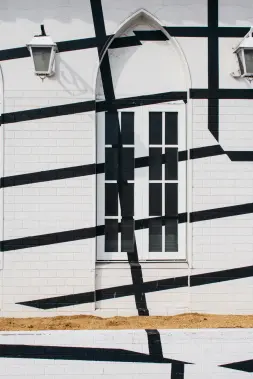Art & Culture
Exploring the Art and Architecture of Naoshima, Japan’s Art Island

-
- DESTINATION NAME
- Kagawa
-
- RELATED TAGS
-
- LAST UPDATED
- 27 April, 2021
The idea of transforming the islands of the Seto Inland Sea into a destination for art and design enthusiasts began to take shape near the tail end of Japan’s economic boom in the late 1980s. What started only as a dream has resulted in the creation of a key destination for serious connoisseurs of modern art and architecture.
There is so much for an art and architecture enthusiast to see and do on Naoshima that I wanted to stay overnight to continue my adventure the following day. Suffice it to say that the following recommendations are barely scratching the surface of what you can see and do on this uniquely beautiful island in the Setouchi area.
Japanese Modern Art at Naoshima’s Port
It’s almost impossible to miss the enormous Red Pumpkin that welcomes visitors to Naoshima. According to the artist Yayoi Kusama, “a red sunbeam searched the outer reaches of the universe only to metamorphose into a red pumpkin in the sea off Naoshima.” Widely acknowledged as one of Japan’s most important living artists, Kusama continues to make modern art that is seriously playful. Go inside the pumpkin and peer through its portholes to watch ferries coming and going. Kids will love it! This is such a refreshing take on modern art.
Nearby is Naoshima Pavilion, created by Sou Fujimoto, and appears like a floating island. However, inside its white shell, the feeling is entirely different. From its entrance, I felt that the structure was being reflected on the surface of the water. Once inside, its geometric design overwhelmed my senses to the point where I thought the entrance had vanished. Take your time to see what it means to you. If you get a chance, visit at night to see it fully illuminated.
Naoshima Bath “I♥︎湯”, designed by Shinro Ohtake, is an art installation that doubles as a public bath and was conceived as a place for residents and visitors to interact. This building is ingenious, labyrinthine, and eclectic! It seemed like the height of kitsch at first, but I found it nonetheless intriguing. With all its trinkets and baubles, it looks more like a two-dimensional drawing than a building! This bathhouse is very funky. Definitely stop here if you are an anime fan, as it looks like a portal to a different world. You may need to bring your own towel and soap but ask at the front to see if you can purchase them on site.
Behind the public bath, I found a warren of narrow alleyways weaving themselves among neat little houses. This has got to be a remnant of the time before automobiles. Look closely, and you’ll find stylish restaurants and bars along the perimeter of this quaint residential area. It’s surprising that private adventures like these can be experienced so close to the ferry terminal.
Naoshima: A Heaven for Cyclists in Japan
With its moderate climate, Naoshima is heaven for cycling enthusiasts. Even if you didn’t bring your own bike to Japan, there are many storefronts just across the road from the ferry terminal where you can rent regular bikes and E-bikes at reasonable rates.
The Pumpkin is Alive!
I wish I had brought a picnic lunch to enjoy on the beach while admiring Yayoi Kusama’s Yellow Pumpkin, my personal favorite art installation on Naoshima. You’ll find the yellow pumpkin sitting on a pier nearby the Benesse House Museum. The pumpkin looks like a mysterious creature that has washed up on the shore of a distant sea. With black polka dots appearing to circulate underneath the pumpkin’s translucent yellow flesh, I sensed it might roll back into the sea at any moment.
The Perfect Marriage of Architecture and Art on Naoshima
Benesse House Museum, designed by Tadao Ando, is a complete joy to walk to from the beach below. As I ascended the hill to the museum, I could hear the sea gently lapping at the beautiful shores. Sweeping vistas out to sea are accentuated by the utter peace and quiet of the surrounding landscape. Take some time to visit the many art installations that dot the pathway to the museum.
With its extraordinary use of natural light, its vast open spaces, and thought-provoking artworks, there is no wonder why Benesse House Museum is considered to be a world-class modern art museum. You will see two boats, one yellow and one black, on a distant beach — something that will catch your eye either before or after you enter the museum. Inside, you’ll understand the boats’ significance with some of the artwork within the museum. I won’t spoil the surprise for you— you’ll just have to visit to see it for yourself! The museum looks as if it is out of a James Bond movie with its stunning views and magnificent architecture. This museum alone is well worth the visit to Naoshima.
ANDO MUSEUM appears to be a well-maintained traditional Japanese house from the outside, but you will find Ando’s modernist architecture at its heart. Beyond the museum’s collection of architectural drawings and models, you’ll find a circular concrete room located deep below the main gallery. It’s the natural light seeping in from a hidden skylight that draws your attention. For Ando, it’s the creation of space that matters, not the construction of buildings.
This is a fantasy land where the impossible seems possible! Just outside the Ando Museum, I saw a stone staircase disappearing into the undergrowth of a nearby hillside and I decided to explore. You’ll want to allow extra time for such diversions on Naoshima.
What to Do While Waiting Between Ferry Journeys to Naoshima
I wouldn’t say I like to spend time waiting, so I was delighted to find two excellent diversions at Uno Port before I boarded my ferry to nearby Naoshima in the Seto Inland Sea.
Chinu, the Black Sea Bream of Uno, created using the Yodogawa Technique, which uses garbage to create their artworks, is an excellent distraction at Uno port. Just walk about 300 meters southeast of the ferry terminal, and you can’t miss it. The sculpture, created from empty cans, PET bottles, and other cast-offs from households, is art with a purpose. It is a stark reminder of man’s impact on the world’s oceans.
If you have an hour or more before you board your next ferry, I highly recommend a visit to the Setouchi Onsen Tamanoyu, especially if your muscles are a bit achy after cycling. The cost of entry to this chic hot spring is quite reasonable, and it is just a 5-minute walk east of the ferry terminal.
Naoshima, in the Seto Inland Sea, with its numerous art installations and natural beauty, is a truly peaceful retreat from the crowded cities of Japan. I never imagined how island life in Japan could be so different from the mainland. The fact that you have to board a ferry means that you need to slow down. Naoshima is not a place to snap a few selfies and then start running to the next “instagrammable” spot. On the contrary, you’ll want to spend quality time here.
How To Get To Naoshima?
Naoshima is around a 20-minute ferry ride from Uno Port in Okayama Prefecture. The closest Shinkansen high-speed bullet train station, which connects Tokyo, Kyoto, Osaka, Hiroshima, and Fukuoka, is JR Okayama Station. From JR Okayama Station, take the JR Uno Line to its terminus, JR Uno Station. The ferry terminal is across the road from the station.
How To Get To Naoshima From Tokyo
There is a direct service between Tokyo and Okayama on the JR Tokaido-Sanyo line. From JR Okayama Station, take the JR Uno Line to its terminus, JR Uno Station. The ferry terminal is across the road from the station.
How To Get To Naoshima From Kyoto
There is a direct train between Kyoto and Okayama on the JR Tokaido-Sanyo line. From JR Okayama Station, take the JR Uno Line to its terminus, JR Uno Station. The ferry terminal is across the road from the station.
How To Get To Naoshima From Osaka
There is a direct service between Osaka and Okayama on the JR Tokaido-Sanyo line. From JR Okayama Station, take the JR Uno Line to its terminus, JR Uno Station. The ferry terminal is across the road from the station.
How To Get To Naoshima From Kobe
There is a direct service between Kobe and Okayama on the JR Tokaido-Sanyo line. From JR Okayama Station, take the JR Uno Line to its terminus, JR Uno Station. The ferry terminal is across the road from the station.
Photographs and text by David Ellis
RELATED DESTINATION
Kagawa
This is an area with many islands, including Naoshima and Teshima, which are famous for art. It also is home to the tasteful Ritsurin Garden. Kagawa is also famous for its Sanuki udon, which is so famous it attracts tourists from throughout Japan. The prefecture is even sometimes referred to as “Udon Prefecture.” [Photo : “Red Pumpkin” ©Yayoi Kusama,2006 Naoshima Miyanoura Port Square | Photographer: Daisuke Aochi]
